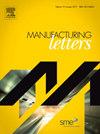Evaluation and quantification of diffusion wear between cutting chip and workpiece using forging press
IF 1.9
Q3 ENGINEERING, MANUFACTURING
引用次数: 0
Abstract
The state of the interface between the workpiece and the cutting tool affects the cutting temperature and pressure on the tool surface during the cutting process. In particular, while cutting difficult-to-cut materials such as Ni-based alloy 718, the workpiece exhibits a high affinity for cutting tool materials and could easily adhere to them. Adhesion can, at times, adversely affect productivity. The diffusion between the cutting tool and the workpiece is a factor considered to contribute to the adhesion phenomenon during cutting. Addressing this issue involves choosing tool materials and coated materials with high resistance to diffusion and optimizing cutting conditions, particularly the cutting speed, which significantly impacts cutting temperature. However, because cutting tool wear comprises various forms, clarifying the effect of diffusion on tool wear remains open. In this study, to reproduce the diffusion phenomenon between cutting tool and workpiece, two pairs of test specimens were prepared: (1) cemented carbide-AISI 1045 and (2) cemented carbide-Alloy718, which could be held at high temperature under vacuum conditions by a forging press. The degree of diffusion phenomena was evaluated at each tool-work material interface, and the quantification of diffusion amount was performed by diffused element in each work material. Additionally, the theoretical analysis of the diffusion phenomenon using the thermodynamic and phase diagram calculation software Thermo-Calc was also performed.
使用锻造压力机评估和量化切屑与工件之间的扩散磨损
在切割过程中,工件与切割工具之间的界面状态会影响切割温度和工具表面的压力。特别是在切削镍基合金 718 等难切削材料时,工件与切削工具材料的亲和力很高,很容易发生粘附。粘附有时会对生产率产生不利影响。切削工具和工件之间的扩散被认为是造成切削过程中粘附现象的一个因素。要解决这一问题,就必须选择抗扩散能力强的刀具材料和涂层材料,并优化切削条件,特别是对切削温度有重大影响的切削速度。然而,由于切削刀具的磨损形式多种多样,因此澄清扩散对刀具磨损的影响仍是一个未知数。在本研究中,为了再现切削工具和工件之间的扩散现象,制备了两对测试试样:(1) 硬质合金-AISI 1045 和 (2) 硬质合金-Alloy718,这两对试样可通过锻造压力机在真空条件下保持高温。对每种工具-材料界面的扩散现象程度进行了评估,并按每种工作材料中的扩散元素对扩散量进行了量化。此外,还使用热力学和相图计算软件 Thermo-Calc 对扩散现象进行了理论分析。
本文章由计算机程序翻译,如有差异,请以英文原文为准。
求助全文
约1分钟内获得全文
求助全文
来源期刊

Manufacturing Letters
Engineering-Industrial and Manufacturing Engineering
CiteScore
4.20
自引率
5.10%
发文量
192
审稿时长
60 days
 求助内容:
求助内容: 应助结果提醒方式:
应助结果提醒方式:


